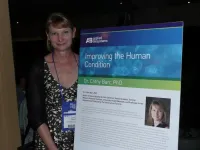(Press-News.org) Researchers have come up with a new way to identify more infectious variants of viruses or bacteria that start spreading in humans - including those causing flu, COVID, whooping cough and tuberculosis.
The new approach uses samples from infected humans to allow real-time monitoring of pathogens circulating in human populations, and enable vaccine-evading bugs to be quickly and automatically identified. This could inform the development of vaccines that are more effective in preventing disease.
The approach can also quickly detect emerging variants with resistance to antibiotics. This could inform the choice of treatment for people who become infected - and try to limit the spread of the disease.
It uses genetic sequencing data to provide information on the genetic changes underlying the emergence of new variants. This is important to help understand why different variants spread differently in human populations.
There are very few systems in place to keep watch for emerging variants of infectious diseases, apart from the established COVID and influenza surveillance programmes. The technique is a major advance on the existing approach to these diseases, which has relied on groups of experts to decide when a circulating bacteria or virus has changed enough to be designated a new variant.
By creating ‘family trees’, the new approach identifies new variants automatically based on how much a pathogen has changed genetically, and how easily it spreads in the human population – removing the need to convene experts to do this.
It can be used for a broad range of viruses and bacteria and only a small number of samples, taken from infected people, are needed to reveal the variants circulating in a population. This makes it particularly valuable for resource-poor settings.
The report is published today in the journal Nature.
“Our new method provides a way to show, surprisingly quickly, whether there are new transmissible variants of pathogens circulating in populations - and it can be used for a huge range of bacteria and viruses,” said Dr Noémie Lefrancq, first author of the report, who carried out the work at the University of Cambridge’s Department of Genetics.
Lefrancq, who is now based at ETH Zurich, added: “We can even use it to start predicting how new variants are going to take over, which means decisions can quickly be made about how to respond.”
“Our method provides a completely objective way of spotting new strains of disease-causing bugs, by analysing their genetics and how they’re spreading in the population. This means we can rapidly and effectively spot the emergence of new highly transmissible strains,” said Professor Julian Parkhill, a researcher in the University of Cambridge’s Department of Veterinary Medicine who was involved in the study.
Testing the technique
The researchers used their new technique to analyse samples of Bordetella pertussis, the bacteria that causes whooping cough. Many countries are currently experiencing their worst whooping cough outbreaks of the last 25 years. It immediately identified three new variants circulating in the population that had been previously undetected.
“The novel method proves very timely for the agent of whooping cough, which warrants reinforced surveillance, given its current comeback in many countries and the worrying emergence of antimicrobial resistant lineages,” said Professor Sylvain Brisse, Head of the National Reference Center for whooping cough at Institut Pasteur, who provided bioresources and expertise on Bordetella pertussis genomic analyses and epidemiology.
In a second test, they analysed samples of Mycobacterium tuberculosis, the bacteria that causes Tuberculosis. It showed that two variants with resistance to antibiotics are spreading.
“The approach will quickly show which variants of a pathogen are most worrying in terms of the potential to make people ill. This means a vaccine can be specifically targeted against these variants, to make it as effective as possible,” said Professor Henrik Salje in the University of Cambridge’s Department of Genetics, senior author of the report.
He added: “If we see a rapid expansion of an antibiotic-resistant variant, then we could change the antibiotic that’s being prescribed to people infected by it, to try and limit the spread of that variant.”
The researchers say this work is an important piece in the larger jigsaw of any public health response to infectious disease.
A constant threat
Bacteria and viruses that cause disease are constantly evolving to be better and faster at spreading between us. During the COVID pandemic, this led to the emergence of new strains: the original Wuhan strain spread rapidly but was later overtaken by other variants, including Omicron, which evolved from the original and were better at spreading. Underlying this evolution are changes in the genetic make-up of the pathogens.
Pathogens evolve through genetic changes that make them better at spreading. Scientists are particularly worried about genetic changes that allow pathogens to evade our immune system and cause disease despite us being vaccinated against them.
“This work has the potential to become an integral part of infectious disease surveillance systems around the world, and the insights it provides could completely change the way governments respond,” said Salje.
END
System to auto-detect new variants will inform better response to future infectious disease outbreaks
2025-01-01
ELSE PRESS RELEASES FROM THIS DATE:
Key players in brain aging: New research identifies age-related damage on a cellular level
2025-01-01
SEATTLE, WASH.—January 1, 2025—Scientists at the Allen Institute have identified specific cell types in the brain of mice that undergo major changes as they age, along with a specific hot spot where many of those changes occur. The discoveries, published in the journal Nature, could pave the way for future therapies to slow or manage the aging process in the brain.
Key findings
Sensitive cells: Scientists discovered dozens of specific cell types, mostly glial cells, known as brain support cells, that underwent significant gene expression changes with age. Those strongly affected included microglia and border-associated ...
Pupil size in sleep reveals how memories are sorted, preserved
2025-01-01
ITHACA, N.Y. – Cornell University researchers have found the pupil is key to understanding how, and when, the brain forms strong, long-lasting memories.
By studying mice equipped with brain electrodes and tiny eye-tracking cameras, the researchers determined that new memories are being replayed and consolidated when the pupil is contracted during a substage of non-REM sleep. When the pupil is dilated, the process repeats for older memories. The brain’s ability to separate these two substages of sleep with a previously unknown micro-structure is what ...
Revealing a key mechanism of rapid centromere evolution
2025-01-01
A joint research group team led by Sayuri Tsukahara and Tetsuji Kakutani of the University of Tokyo has clarified a mechanism of how retrotransposons, genetic elements that can “jump around” chromosomes and are known drivers of evolution, preferentially insert in the centromere. The findings were published in the journal Nature.
The centromere is the thinnest part of the chromosome that divides it into a long and short arm, much like how the waist separates the upper and lower body. Its role in transmitting information via cell division has been preserved ...
A tour de force: Columbia engineers discover new “all-optical” nanoscale sensors of force
2025-01-01
New York, NY—January 1, 2025—Mechanical force is an essential feature for many physical and biological processes. Remote measurement of mechanical signals with high sensitivity and spatial resolution is needed for a wide range of applications, from robotics to cellular biophysics and medicine and even to space travel. Nanoscale luminescent force sensors excel at measuring piconewton forces, while larger sensors have proven powerful in probing micronewton forces. However, large gaps remain in the force magnitudes that can be probed remotely from subsurface ...
Ancient DNA unlocks new understanding of migrations in the first millennium AD
2025-01-01
Francis Crick Institute press release
Under strict embargo: 16:00 GMT Wednesday 1 January 2025
Peer reviewed
Observational study
Ancient people
Ancient DNA unlocks new understanding of migrations in the first millennium AD
Waves of human migration across Europe during the first millennium AD have been revealed using a more precise method of analysing ancestry with ancient DNA, in research led by the Francis Crick Institute.
Researchers can bring together a picture of how people moved across the world by looking at changes in their DNA, but this becomes a lot harder when historical ...
MIT scientists pin down the origins of a fast radio burst
2025-01-01
Fast radio bursts are brief and brilliant explosions of radio waves emitted by extremely compact objects such as neutron stars and possibly black holes. These fleeting fireworks last for just a thousandth of a second and can carry an enormous amount of energy — enough to briefly outshine entire galaxies.
Since the first fast radio burst (FRB) was discovered in 2007, astronomers have detected thousands of FRBs, whose locations range from within our own galaxy to as far as 8 billion light-years away. Exactly how ...
Researchers reveal why the lung is a frequent site of cancer metastasis
2025-01-01
Leuven, 2 January 2024 – Researchers from the lab of Prof. Sarah-Maria Fendt (VIB-KU Leuven) and colleagues have uncovered that the availability of the amino acid aspartate is one reason why the lung is a frequent organ of metastasis. Their work appears in Nature and improves our understanding of cancer biology while providing the foundation for new therapeutic interventions in metastatic diseases.
A role for aspartate
More than half of cancer patients in whom the cancer spreads beyond the primary site have lung metastases. What makes the lungs such a ...
Aging may change some brain cells more than others
2025-01-01
EMBARGOED FOR RELEASE: Jan. 1, 2025, 11 a.m. ET
CONTACT:
NIAPressTeam@mail.nih.gov, 301-496-1752
Aging may change some brain cells more than others
NIH-funded mouse study provides roadmap for how aging may alter brain cell genetic activity
Based on new brain mapping research funded by the National Institutes of Health (NIH), scientists have discovered that not all cell types in the brain age in the same way. They found that some cells, such as a small group of hormone-controlling cells, may undergo more age-related changes in genetic activity than others. The results, published ...
Special issue of APA’s official journal focuses on psychedelic medication
2025-01-01
WASHINGTON, D.C., Jan. 1, 2025—As the body of research grows around the potential promise of psychedelic medications in psychiatry, many questions and challenges remain. The January issue of the American Journal of Psychiatry features a series of articles, including new research, reviews and commentaries, on the use of these treatments.
The issue addresses many of the ongoing challenges and looming questions in the field of psychiatric psychedelic research and treatment. These include issues relevant to basic ...
Geneticist unlocks mysteries of childhood psychiatric disorders through innovative research
2024-12-31
TORONTO, Ontario, Canada, 31 December 2024 - In a comprehensive Genomic Press Interview, leading geneticist Dr. Cathy Barr unveils crucial discoveries about the complex interplay between genes and childhood psychiatric disorders. As a Senior Scientist at both the Hospital for Sick Children and Krembil Research Institute, Dr. Barr's research illuminates the genetic foundations of conditions including depression, attention-deficit/hyperactivity disorder, reading disabilities, and Tourette syndrome.
"After decades of searching ...





